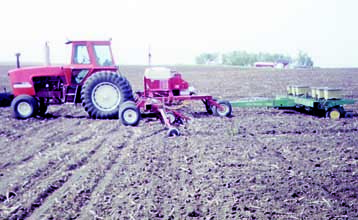"I call it my poor man's interplanter because I don't have a lot of money invested in it. It's very simple to operate and lets me plant soybeans in 18-in. rows and corn in 36-in. rows," says Denny Neubauer, Radcliffe, Iowa. He owned an IH 500 3-pt. mounted, 8-row, 36-in. planter equipped with newer-style model 800 row units as well as lift assist wheels. He paid for a used Deere 7000 8-row, 30-in. planter equipped with Kinze bean meters and converted it to a 7-row, 36-in. planter. He pulls the Deere planter behind the IH planter when planting beans. To split the rows made by the IH planter, he offset the row units on the Deere planter and mounted a hitch on back of the IH planter. The Deere planter has a single row unit at the center, which results in two 30-in. skip rows for spraying. To raise and lower the Deere planter, he "T'd" the the lift assist wheel hydraulics on the IH planter into the Deere planter's hydraulics. He also shortened up the IH planter markers on each side by 18 in. and extended the planter's monitor extension cord back to the Deere planter. " It saved me a lot of money because new interplanters that do what this rig does sell for much more than what I spent," says Neubauer. "I used it last spring to plant more than 700 acres of soybeans and it worked great, even though I had to go through some pretty tough wet spots. Yields ranged from 50 to 67 bu. per acre. I planted about 175,000 seeds per acre. I think the narrow 18-in. rows resulted in a 3 to 4 bu. per acre yield advantage, so my Deere interplanter paid for itself the first year. The narrow rows provide early shading which reduces the need for herbicides. I planted some Roundup Ready beans but mostly conventional beans. "My neighbor Jim Spaid made most of the modifications to the Deere planter, but the entire neighborhood contributed ideas. "I use the IH planter by itself to plant corn. To plant soybeans I back the IH planter up to the Deere planter and hitch it up, then hook up the hydraulic hose and the monitor cord. I didn't have to add any extra control levers in order to raise or lower the Deere planter. Instead, I use the same hydraulic lever that controls the lift assist wheels on the IH planter to raise or lower the Deere planter. I raise the IH planter on-the-go at the end of the field, and by some engineering fluke there's a delay in the hydraulics so that the Deere planter raises up at about exactly the same spot as the IH planter. "I thought that I'd have problems turning at the end of the field, but the long hitch on the Deere planter allows it to turn tight behind the IH planter."
1-800-834-9665
"Poor Man's Interplanter"
FARM SHOW Magazine » "Poor Man's Interplanter"
"Poor Man's Interplanter"
